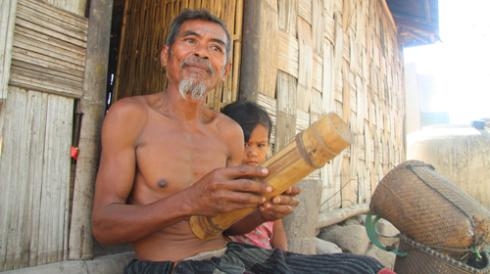Ma Noi, a village inhabited by the Raglai in the remote mountains of Ninh Son District in central Ninh Thuan Province, has simple stilt houses and herds of white goats grazing in the hills.
 |
| Chammalé Au usually sits on the doorstep of his house and plays chapi melodies that most people no longer remember - photo by Vien Su |
One resident here, Chammalé Au, still plays the chapi, a simple string instrument made of bamboo.
Au, who lives in a valley near Ma Noi Spring, brings from the kitchen loft a long bamboo pipe that looks like a hunter’s quiver and says, “It’s the chapi of ama (he refers to himself as father to this writer).”
In the old days every Raglai used to possess one. It was played both on sad and joyous occasions.
Smoking a cigarette, Au tells about the old days when as a young boy he heard chapi music coming from other houses.
The instrument produces a sound similar to the ma la, a kind of gong used in all Raglai ceremonies and possessed only by the rich.
Lifting the chapi to his chest, Au begins to pluck it. His thumbs press down on the strings -- eight bamboo splints in four pairs. It produces a deep sound and the tempo is neither fast nor slow, just like Raglai life.
Chapi melodies have simple names. The Frog is played on the first nights of the rainy season to remind people to collect grains from their fields early next morning; the Bird is used to indicate the time of the day; the Forgetting Belongings seeks to ask others about belongings lost in the field and elsewherel; the Lament expresses unhappiness about crop failures or a sick pig; the I stay, you go speaks for lovers saying goodbye to each other.
The chapi is small but is the quintessence of Raglai culture. Stopping in the middle of a piece, Au explains the meaning of the four pairs of strings of varying thickness.
The first pair symbolizes the mother and the second, the father. The next two are the daughter and son and are thinner and produce higher pitches.
Since the Raglai are a matriarchal society, a chapi melody always begins with the mother.
The Raglai usually take along a chapi to play when going to the fields. The music is based on the rhythm of walking to the fields and, generally, the leisurely pace of their life.
Au has received many certificates of merit from provincial and national governments for his chapi performances.
“Ama [I] has performed many times in faraway places, but doesn’t feel happy because young people in Ma Noi cannot play the chapi.”
Counting on the joints of the fingers on his left hand, he says: “Phuoc Thanh still has Chammalé Liep, Phuoc Binh has Chammalé Phong… but [they] are already infirm.
“The children only like noisy music. Ama asks them to come to take chapi lessons but none of them can learn.”
Putting the chapi on the doorstep, he says: “It looks easy to make but not many boys want to go find this thorny bamboo pipe because the forests have become so thin.
“The bamboo must be round, have a glossy and thin bark, and grow on top of high hills because any lower and its roots will absorb too much water and the sound will not be melodious.”
He has to wait for nearly two years to find a suitable bamboo stem for making it. First, he looks for an eye-catching green bamboo bush, marks it, and waits for more than a year until its skin turns yellow. He then cuts it into separate pipes and hangs them over the kitchen stove for three or four months to make them dry and stiff.
To make a chapi, he uses a knife to cut the bark of the dried bamboo lengthwise but leaves it attached to the wood. He then slices the bark into four pairs of splints of different thickness. He then inserts bamboo strips under the splints at both ends and ties them up with strings made from a plant.
In the village, only Au and Mao Ngoc Thang, a researcher of Raglai culture and former vice chairman of the Ninh Son District people’s committee, can make the chapi since they remember all the melodies.
It takes a long time to learn to play the chapi. Au does not remember how long he took – only that he learnt it from his uncle since boyhood and practiced constantly. He mastered all 15 chapi melodies only after he had eight children.
Chapi melodies are hard to remember since it does not have notations unlike the music of many other ethnic groups.
Au remembers having lived for nearly 60 seasons of crops (years). He is still healthy enough to climb hills to chop bamboo and still likes to wait for the bamboo to grow yellow in the forest and dry in the kitchen loft to make the chapi.
However, he is afraid he will not live long enough to leave his legacy for posterity.
Musician Phan Quoc Anh, who is the director of the Ninh Thuan Department of Culture, Sports and Tourism, says Chammalé Au is the best Raglai chapi player in the province.
His department plans to record all the melodies he remembers to preserve this vanishing music genre, he says.

Leave your comment on this story